The February 2016 unemployment report is being reported as great news once again. The official unemployment rate is 4.9%, a rate not seen since February 2008 and no change from January. Overall, this month's CPS does have some great news in it. There were over half a million more employed than the previous month and those not in the labor force declined by over 300 thousand. The labor participate rate ticked up two tenths of a percentage point to a still very low 62.9%. That said, one month's changes in the household survey does not a trend make, yet this report has many strong positive indicators.
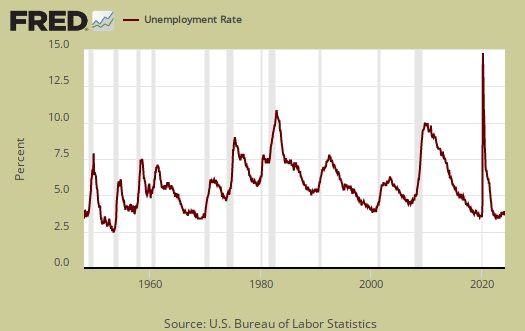
This article overviews and graphs the statistics from the Employment report Household Survey also known as CPS, or current population survey. The CPS survey tells us about people employed, not employed, looking for work and not counted at all. The household survey has large swings on a monthly basis as well as a large margin of sampling error. This part of the employment report is not about actual jobs gained but people and their labor status.
Those employed now stands at 151,074,000, a monthly gain of 530 thousand. From a year ago, the ranks of the employed has increased by 2.843 million.
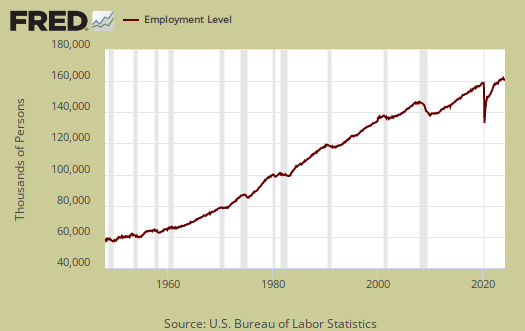
Those unemployed number 7,815,000. From a year ago the unemployed has decreased by -831,000. The monthly change of those unemployed is really unchanged, a gain of 24 thousand.

Those not in the labor force is 93.688 million. The monthly decline was -374,000. The below graph are the not in the labor force ranks. Those not in the labor force has increased by 666,000 in the past year, a huge improvement from the annual change of past months.

The labor participation rate is 62.9%, This is a 0.2 percentage point increase from last month, but the rate is still at 1980's lows.

Below is a graph of the labor participation rate for those between the ages of 25 to 54. The rate is 81.2%, a level not seen since February 1985, discounting events after 2008. These are the prime working years where one should not see record low participation rates or see what appears to be oscillation since the 2008 financial crisis.
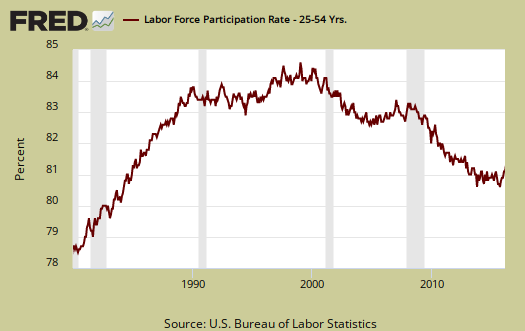
The civilian labor force, which consists of the employed and the officially unemployed, stands at 158,890,000. The civilian labor force has grown by2,012,000 over the past year and grew by 555 thousand in the past month alone. New workers enter the labor force every day from increased population inside the United States and both legal and illegal immigration.

Those not in the labor force now grows less the population which has the potential to work, a very recent trend reversal. Below is a graph of those not in the labor force, (maroon, scale on the left), against the noninstitutional civilian population (blue, scale on the right). Notice how those not in the labor force crisscrosses the noninstitutional civilian population in growth and this started happening in 2008.
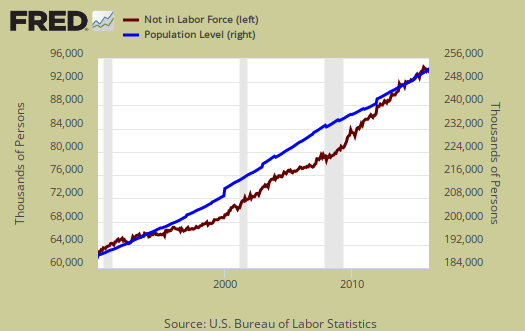
Below is a graph of the civilian labor force, or the official employed plus unemployed, in maroon, scale on left, against those not in the labor force, in blue, scale on right. See how those not in the labor force as a trend exceeded those considered employed and unemployed starting around mid 2009. Starting in 2014 it has reverted back, yet look at how is it reverted once again in 2015 and now swinging back. This shows those not in the labor force has been growing much faster than those obtaining jobs and being counted as looking for work. Those not in the labor force does include retirees and students.

Those considered employed as a ratio to the total Civilian noninstitutional population now stands at 59.8%, a level not seen since June 1985, barring the financial crisis aftermath. This is actually an improvement of two tenths of a percentage point from last month. The relationship between the employment-population ratio and the labor participation rate (LPR) is: employment-population ratio = LPR * (1 - unemployment rate).
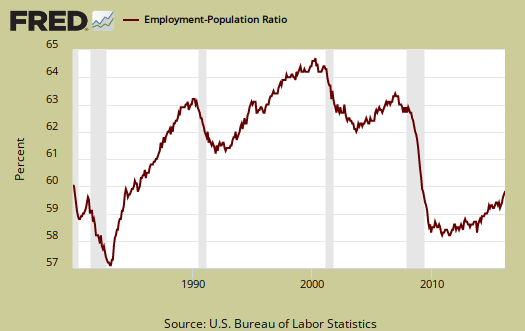
Those forced into part time work for economic reasons stands at 5,998,000 people. This is literally no change from last month. The annual decrease is now -642 thousand.

There are two categories of those forced into part-time jobs due to economic circumstances. Those who could only get part-time jobs and those already working who got their hours cut due to businesses not having enough work for them. The number of people who could only get part-time jobs stands at 2,104,000 as shown below.

People can also work part-time hours due to slack business demand. People who got their hours cut due to slack working conditions stands at 3,579,000. Below is a graph of forced into part-time work because they got their hours cut, as a percentage of the total employed. This is a recession economic indicator.

Part-time workers who are voluntarily working part-time jobs is a whopping 20,615,000.

U-6 now stands at 9.7%, a 0.2 percentage point decrease from last month. U-6 is a broader measure of unemployment and includes the official unemployed, people working part-time hours because that's all they can get and a subgroup not counted in the labor force but are available for work and looked in the last 12 months. The U-6 rate still leaves out some people wanting a job who are not considered part of the labor force, so while it is called an alternative rate, but it still ignores many who should be counted as unemployed.

The newly unemployed stands at 2,297,000, a 48 thousand monthly increase. Below is a graph of those unemployed for less than five weeks.

The long term unemployed, or those unemployed for 27 weeks and over, is 2,165,000 people. This is a 76 thousand monthly increase. From a year ago the long term unemployed ranks has declined by -512,000.
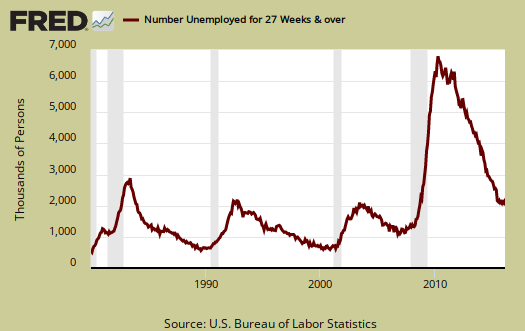
Within the CPS survey is how many people who are considered not in the labor force who report they want a job now. It is a direct survey question. The Census asks people who are not being counted in the unemployment statistics and official unemployment rate if they want a job. The number who answer yes currently stands at 5,870,000. Those who are not counted yet report they want a job includes the discouraged workers and marginally attached and is seasonally adjusted. Those not in the labor force who report they want a job declined by 618 thousand from a year ago. For the month thise figure declined by 103 thousand.
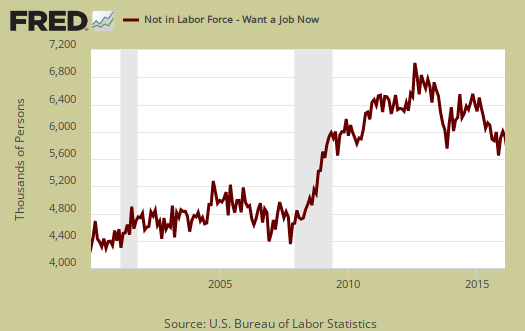
The average length of unemployment is 29 weeks. The average time to be unemployed has stayed completely out of line with the median duration.
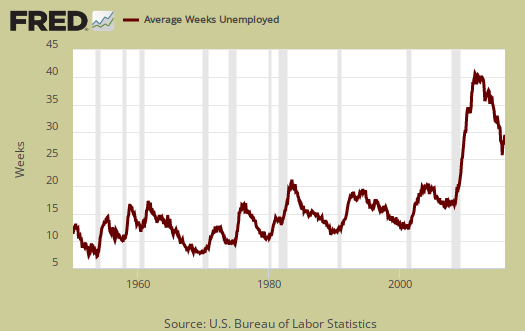
The median time one is unemployed, which means 50% of people have gotten a job in this amount of time is 11.2 weeks. A year ago the median time to be unemployed was 13 weeks.

This month's CPS report gives a not just a nice headline number but the best monthly changes seen in quite a while. That said, the CPS is notoriously volatile with 100,000 data size swings routine from month to month. Is the household survey finally going to show some real hope for working Americans? It's too early to tell and yes we know it is 2016 and not 2010. Here are our past overviews CPS unemployment statistics, only graphs revised.

fractional counts of employed and unemployed..
found out something i hadnt realized with this report...they extrapolate each metric from the survey separately, and since we're talking people, they obviously round to whole numbers...but what we saw this week was that the seasonally adjusted count of those who were employed rose by 530,000 and the number of unemployed rose by 24,000, while the labor force increased by 555,000, meaning there significant fractional people who were either employed or unemployed, enough to add up to another whole person in the labor force..
rjs
off by 1,000 due to rounding in counts
530 + 24 = 554.
off by 1.
Yes each series has it's own seasonal adjustment but on table A they do add unless there is a rounding issue, cumulative.
The GDP report really has these as each is also computed separately, if one noticed on the components.
At this rate...
...we shouldn't be surprised if after the next 10 years the unemployment rate will be -4.9%
Just curious...If there are 374,000 less people that are "not in the labor force", did they either find work or die?
I'm assuming they didn't retire or go on disability, right?
not in the labor force includes disabled, retired
I don't know the natural death and birth rates but I *thought* those natural rates were in the adjustments already, i.e. population controls from the Census.
From the increase in employed it is possible that those not in the labor force found jobs, but month to month correlations are spurious at best, need at least a quarter of data to imply anything, a year is really the valid marker.